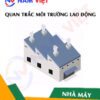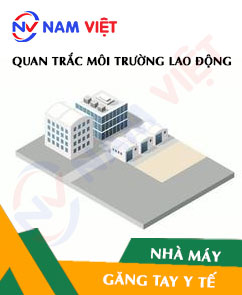Occupational environment monitoring of an electronic component manufacturing factory
99,000 ₫
Note: The above price is calculated for one sample, and the price may fluctuate depending on the area of the environment to be monitored and market movements. For more accurate pricing support, please refer to the price list or contact our consulting staff directly.
Monitoring the environment of an electronic component manufacturing factory is a session of collecting, analyzing, and evaluating factors at the workplace that may harm workers health.
Table of Contents
Toggle1. Overview of Electronic Component Manufacturing Factories
a. What is an Electronic Component Manufacturing Factory?
Factory producing electronic components is a facility that manufactures parts and components used in electronic devices such as mobile phones, computers, entertainment devices, and other electronics.
This factory produces parts such as microchips, ICs, resistors, capacitors, coils, LEDs, touch screens, sensors, and other components.
These components are manufactured through processes such as metal processing, circuit printing, surface treatment, assembly, and quality inspection. Electronic component factories are usually large-scale and use modern production technology to ensure quality and mass production capacity.

b. Production Processes in Electronic Component Manufacturing Factories
Production processes in electronic component manufacturing factories include:
- Design and development: Factories start with designing and developing products. This process is crucial to ensure product stability and quality.
- Metal processing: Metal components are processed from metal sheets. This stage includes cutting, bending, stamping, packaging, and soldering.
- Circuit printing: This process prints electrical circuits onto metal sheets using conductive materials such as conductive ink or conductive paste.
- Surface treatment: After circuit printing, metal surfaces are coated with protective plating and circuits are protected with a protective layer.
- Assembly: After production, components are assembled onto circuit boards and protected with casings and protective coatings.
- Quality inspection: Finally, electronic components undergo periodic quality tests to ensure product quality and functionality.

c. Machinery Used in Electronic Component Manufacturing Factories
Machinery used in electronic component manufacturing factories includes:
- Metal processing machines: Used to cut, bend, stamp, and solder metal components.
- Circuit printing machines: Used to print electrical circuits onto metal sheets using conductive materials like conductive ink or paste.
- Polishing machines: Used to polish metal components before circuit printing.
- Plating machines: Used to coat protective layers on metal surfaces after circuit printing.
- Packaging machines: Used to package and protect electronic components.
- Quality inspection machines: Used to test functionality and quality of electronic components before final product assembly.
- Testing and evaluation machines: Used to check performance, stability, and durability of electronic components during production.

d. Occupational Diseases Workers May Encounter in Electronic Component Factories
Workers in electronic component factories may face various occupational diseases such as:
- Respiratory diseases: Dust, smoke, toxic fumes, or chemicals released during production can cause respiratory problems such as asthma, pneumonia, or lung cancer.
- Skin diseases: Chemicals used in production may cause skin irritation or other skin conditions such as redness, rashes, or psoriasis.
- Eye diseases: Causes such as reflected light, ultraviolet rays, dust, or toxic chemicals can lead to cataracts, conjunctivitis, or retinal diseases.
- Spine and musculoskeletal diseases: Prolonged standing, improper sitting postures, or excessive loads may cause spinal and joint problems such as herniated discs or joint degeneration.
- Mental health issues: High-pressure work and long working hours may lead to stress, depression, anxiety, and other psychological problems.
- Hearing problems: Noise from factory machinery may cause ear-related issues such as eardrum rupture or hearing loss.
- Nervous system diseases: Toxic chemicals such as lead or mercury used during production may cause neurological disorders like paralysis or nerve damage.

e. Common Electronic Components on the Market
Common electronic components on the market include:
- IC (integrated circuit): A primary component in electronic devices, designed to perform multiple functions on a single chip.
- Transistor: An electronic component that switches signals and is used to amplify or reduce voltage and current.
- Diode: An electronic component that converts AC to DC and is used for current conversion.
- Capacitor: Stores electrical charge and is used to filter noise and stabilize current.
- Resistor: Limits electrical current and is used to adjust current flow.
- Relay: Transfers signals from one circuit to another and is used to control electronic devices.
- Transformer: Alters voltage and current for electronic circuits.
- Sensor: Detects physical or chemical signals and converts them into electrical signals.
- LED (light-emitting diode): Produces light for electronic devices.

2. Overview of Occupational Environment Monitoring Services
a. What is Occupational Environment Monitoring for Electronic Component Factories?
Occupational environment monitoring (or workplace environmental measurement) at electronic component factories involves collecting, evaluating, and analyzing workplace environmental indicators to implement timely measures, minimize environmental hazards to workers’ health, and prevent occupational diseases. Monitoring the occupational environment is mandatory for electronic component factories.
Occupational environment monitoring plays a crucial role in protecting and improving workers’ health, as the workforce is the primary resource directly generating profit for the company. Workers frequently exposed to risk factors and occupational hazards beyond allowable limits may experience health issues and occupational diseases.
REGISTER FOR OCCUPATIONAL ENVIRONMENT MONITORING SERVICE
b. Nam Viet’s Occupational Environment Monitoring Program
Nam Viet’s occupational environment monitoring program is developed by engineers specialized in occupational safety and environmental protection. Aiming to ensure workers’ health and safety, the program uses modern measurement methods to monitor air, water, microclimate, physical factors, dust, and other workplace environmental elements. This program is vital for maintaining a safe working environment and protecting workers’ health.
Additionally, Nam Viet’s monitoring program contributes to research and development of new solutions to improve workplace environmental quality. With the dedication and professionalism of the monitoring experts, Nam Viet’s proprietary program represents a breakthrough in occupational safety management and environmental protection in Vietnam.

c. Standardization in Occupational Environment Measurement Procedures
Standardization in Nam Viet’s occupational environment measurement procedures is essential to ensure accuracy and reliability. The program follows recognized standards and procedures of the Ho Chi Minh City Department of Health. This ensures that collected data are reliable for workplace evaluations and decision-making to improve worker health protection.
These standardized procedures also ensure that measurements are performed by highly qualified monitoring experts with years of experience, allowing managers and specialists to trust Nam Viet’s results and make informed decisions to protect worker health and the environment.
By applying standardization in measurement procedures, Nam Viet demonstrates its commitment to providing a safe working environment, protecting workers’ health, and contributing to improving occupational safety and environmental management in Vietnam.
d. Electronic Component Factory Monitoring Reports
Occupational environment monitoring results are prepared according to Form No. 04, Appendix III, issued with Decree 44/2016/ND-CP and made in 02 copies: 01 copy sent to the contracting workplace and 01 copy retained by the monitoring organization.
The retention period for occupational environment monitoring results is indefinite as required by law.

e. Frequency of Occupational Environment Monitoring as Required by Law
According to Clause 2 of Article 18 of the Law on Occupational Safety and Hygiene 84/2015/QH13, employers must organize workplace monitoring to evaluate harmful factors at least once a year.
f. Deadline for Submitting Occupational Environment Monitoring Reports as Required by Law
The deadline for submission is before December 31 each year. Enterprises at manufacturing facilities must submit occupational environment monitoring reports to the local Department of Health where the facility is headquartered and where workers are employed.
When there are changes in technology, production processes, or during facility upgrades that may introduce new hazardous factors to worker health, enterprises must update occupational hygiene records to reflect the harmful factors requiring monitoring.
g. Penalties for Violations of Occupational Environment Monitoring by Employers
According to Article 27 of Decree No. 12/2022/ND-CP dated January 17, 2022, regulating administrative penalties in labor, social insurance, and Vietnamese workers working abroad under contract:
- Clause 2: Fines ranging from 2,000,000 – 5,000,000 VND for employers who fail to publicly inform workers at the monitored workplace and the location of hazard assessment immediately after receiving monitoring results and hazard evaluation results.
- Clause 3: Fines ranging from 20,000,000 – 40,000,000 VND for employers who do not conduct occupational environment monitoring to control health hazards according to the law.
- Clause 4: Fines ranging from 40,000,000 – 60,000,000 VND for employers who collude with monitoring organizations to commit fraud in occupational environment monitoring but have not reached criminal liability.
3. Harmful Environmental Factors for Workers in Electronic Component Manufacturing Factories
Harmful environmental factors for workers in electronic component manufacturing factories include:
- Dust and chemicals: The production process uses many chemicals and produces dust such as metal particles, fillers, paint dust, solder fumes, etc. If not properly managed and handled, these substances can pose health risks to workers.
- Noise and vibration: Machinery in electronic component factories often operates continuously, generating noise and vibration that affect health and reduce employee productivity.
- Temperature and humidity: Some production processes require tightly controlled temperature and humidity to ensure product quality. However, if not properly managed, they can negatively affect workers’ health.
- Electrical hazards: Employees often work with electrical equipment such as high voltage devices and soldering tools. Improper use or operation can pose health risks.
- Other factors: In addition to the above, other factors such as exposure to radiation and harmful gases like ammonia and chlorine can also impact worker health.
REGISTER FOR OCCUPATIONAL ENVIRONMENT MONITORING SERVICE
4. Measures to Improve the Working Environment in Electronic Component Manufacturing Factories
Measures to improve the working environment in electronic component manufacturing factories include:
- Improve occupational safety management systems: Ensure that procedures and equipment are operated correctly and safely, and that environmental and health risks are properly assessed and managed.
- Use modern equipment and technology: Utilize the latest equipment and technology to minimize worker exposure to harmful substances.
- Train employees on occupational safety: Provide staff with training on occupational safety, including equipment usage and safety measures.
- Use non-toxic substitutes: Employ non-toxic alternatives to reduce health risks to workers.
- Conduct regular inspections: Periodically check procedures and equipment to ensure compliance with safety and environmental requirements.
- Implement environmental monitoring: Monitor the environment to detect health and environmental risks, assess production impact, and develop mitigation measures.
- Ensure safety information: Provide employees with information about occupational and environmental hazards related to their work and guidelines for safe equipment use and health protection.
- Regularly conduct occupational environment monitoring in factories, collecting and analyzing harmful factors for workers, and adjusting to reduce risks and prevent occupational diseases.
5. Benefits of Periodic Monitoring in Electronic Component Manufacturing Factories
An Toan Nam Viet provides enterprises with great benefits when using occupational environment monitoring services according to Decree 44/2016/ND – CP on managing and controlling harmful factors in the working environment affecting workers.
- Enterprises can proactively control harmful factors in factories or workshops.
- Receive consultation and recommendations to reduce harmful factors and improve workplace quality.
- Indirectly protect human resources, a key factor in business development.
- Reduce the impact of occupational diseases on health, minimizing future treatment costs.
- Improved worker health leads to better product quality and consistent production output.
- Comply with occupational safety laws, avoiding legal risks.
- Enhance credibility and professionalism, thereby elevating the enterprise’s brand value.
Nam Viet’s environmental monitoring service is a solution to reduce occupational disease risks, contributing to a clean and high-quality working environment.

6. Nationwide Occupational Environment Monitoring Center
Occupational Environment Monitoring Center of Nam Viet is a professional unit specializing in monitoring and measuring occupational environment quality across all provinces in Vietnam. With an experienced team of monitoring specialists, the center uses modern measurement equipment to ensure accuracy and reliability.
In addition to providing monitoring services, the center assists clients in planning, handling, and tracking occupational environment issues. Following the principle “customer-centered,” the center prioritizes client satisfaction, meets all client needs, and commits to providing the best solutions for enterprises.
REGISTER FOR OCCUPATIONAL ENVIRONMENT MONITORING SERVICE
With investment in technology, equipment, and human resources, Nam Viet’s monitoring center has become a reputable unit in occupational environment monitoring in Ho Chi Minh City, with the following goals:
- We always value brand reputation and service quality.
- We provide clients with the best and most suitable solutions.
- Alongside experienced Masters and Engineers, aiming to protect the environment and benefit enterprises.
- By choosing Nam Viet Environmental Monitoring, your company will receive professional service from experts in monitoring, along with the best cost incentives.
The occupational environment monitoring process at Nam Viet includes the following steps:
- Before monitoring, we ensure that all machinery and equipment used for monitoring are calibrated and compliant with legal regulations.
- Conduct the full monitoring procedures as committed to the Department of Health.
- Report monitoring results honestly to the employer.
- If results indicate unsafe conditions, Nam Viet will assist with corrective measures, and the factory will implement the following:
- Implement measures to improve working conditions, minimize harmful factor impact, and prevent occupational diseases.
- Organize health checks for early detection of occupational and work-related diseases for workers in unsafe positions.
- Provide material compensation for workers according to labor law regulations.

7. Occupational Environment Monitoring Price List
To help enterprises conduct occupational environment monitoring professionally and effectively, Nam Viet provides clients with a price list for occupational environment monitoring services that is high-quality and reasonably priced.
- Our price list provides detailed information on the costs of monitoring services, including transportation, measurement, analysis, and reporting. Clients can fully trust the accuracy and reliability of our monitoring reports.
- We commit to offering competitive and reasonable prices and are always ready to answer any questions about monitoring services promptly and professionally.
- With Nam Viet’s price list, clients can easily select service packages that suit their needs. We guarantee the highest satisfaction with professional service quality.
No comments yet












Review Occupational environment monitoring of an electronic component manufacturing factory
There are no reviews yet.